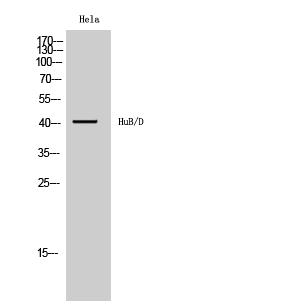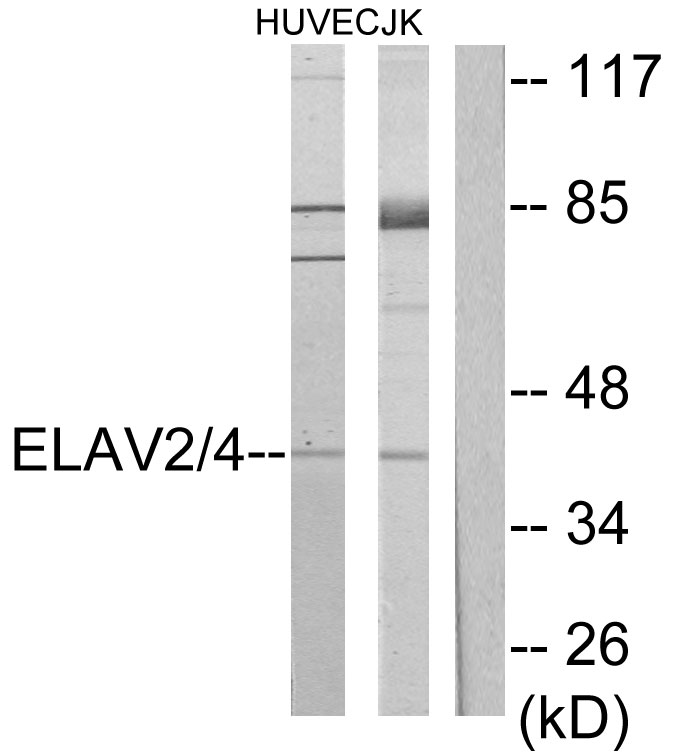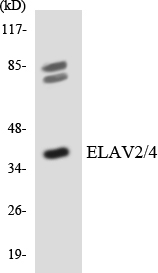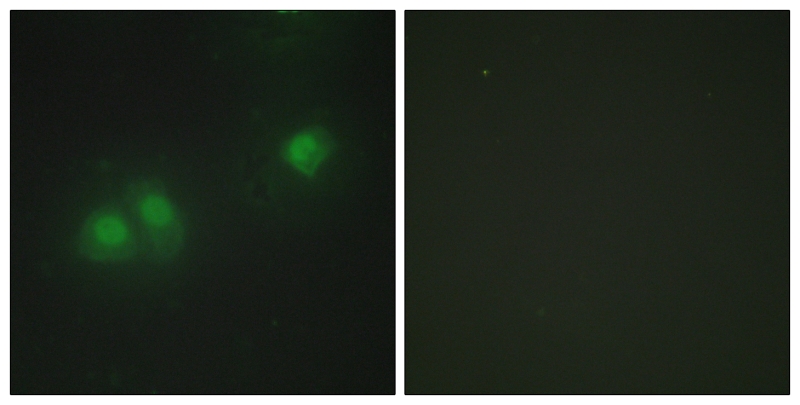



| WB | 1/500-1/1000 | Human,Mouse,Rat |
| IF | 咨询技术 | Human,Mouse,Rat |
| IHC | 1/50-1/100 | Human,Mouse,Rat |
| ICC | 1/50-1/200 | Human,Mouse,Rat |
| FCM | 咨询技术 | Human,Mouse,Rat |
| Elisa | 1/10000 | Human,Mouse,Rat |
| Aliases | ELAVL2; HUB; ELAV-like protein 2; ELAV-like neuronal protein 1; Hu-antigen B; HuB; Nervous system-specific RNA-binding protein Hel-N1; ELAVL4; HUD; PNEM; ELAV-like protein 4; Hu-antigen D; HuD; Paraneoplastic encephalomyelitis antigen HuD |
| Entrez GeneID | 1993/1996 |
| WB Predicted band size | Calculated MW: 40 kDa; Observed MW: 40 kDa |
| Host/Isotype | Rabbit IgG |
| Antibody Type | Primary antibody |
| Storage | Store at 4°C short term. Aliquot and store at -20°C long term. Avoid freeze/thaw cycles. |
| Species Reactivity | Human,Mouse,Rat |
| Immunogen | The antiserum was produced against synthesized peptide derived from human ELAV2/4. AA range:61-110 |
| Formulation | Purified antibody in PBS with 0.05% sodium azide,0.5%BSA and 50% glycerol. |
+ +
以下是关于HuB/HuD抗体的3篇参考文献摘要:
1. **文献名称**: "HuD, a paraneoplastic encephalomyelitis antigen, contains RNA-binding domains and is homologous to ELAV and Sex-lethal"
**作者**: Szabo A, Dalmau J, Manley G, et al.
**摘要**: 该研究首次报道HuD蛋白作为副肿瘤性脑脊髓炎的自身抗原,属于ELAVL家族RNA结合蛋白,在神经元中高表达,其抗体与神经系统副肿瘤综合征密切相关。
2. **文献名称**: "HuD autoantibodies: Diagnostic value in patients with paraneoplastic neurological syndromes"
**作者**: Kingma GW, Lang B, Verschuuren JJ, et al.
**摘要**: 研究通过免疫组化分析证实,HuD抗体是诊断小细胞肺癌相关副肿瘤性神经综合征(如脑脊髓炎)的特异性血清标志物,具有重要临床价值。
3. **文献名称**: "The RNA-binding protein HuD regulates neuronal cell identity and maturation"
**作者**: Akamatsu W, Fujihara H, Mitsuhashi T, et al.
**摘要**: 实验发现HuD通过结合mRNA调控神经突触蛋白(如GAP-43)的稳定性,促进神经干细胞向成熟神经元分化,提示其在神经发育中的关键作用。
(注:HuB与HuD同属ELAVL家族,但HuD研究更集中于神经系统,故文献以HuD为主。)
HuB (ELAVL2) and HuD (ELAVL4) are RNA-binding proteins belonging to the Embryonic Lethal Abnormal Vision (ELAVL) family, primarily expressed in neurons and neuroendocrine cells. They regulate post-transcriptional gene expression by stabilizing target mRNAs and enhancing their translation, playing critical roles in neuronal development, plasticity, and maintenance. Antibodies targeting HuB/HuD are clinically significant as they are associated with paraneoplastic neurological syndromes (PNS), rare autoimmune disorders triggered by cancer-induced immune responses.
These onconeural antibodies are produced when the immune system mistakenly targets HuB/HuD proteins expressed by tumor cells, particularly in small cell lung cancer (SCLC) and neuroblastoma. The cross-reactivity with neuronal Hu proteins leads to neurological damage. Patients often present with syndromes like encephalomyelitis, sensory neuronopathy, or cerebellar ataxia. Detection of Hu antibodies (primarily anti-HuD, classified as ANNA-1) in serum or cerebrospinal fluid aids in diagnosing PNS and prompts cancer screening.
First identified in the 1980s, Hu antibodies are a hallmark of paraneoplastic neurological autoimmunity. Their presence underscores the link between cancer and neurological dysfunction, highlighting the role of immune-mediated mechanisms. Testing involves immunohistochemistry, immunoblotting, or cell-based assays, with early detection crucial for managing both neurological symptoms and underlying malignancies.
×